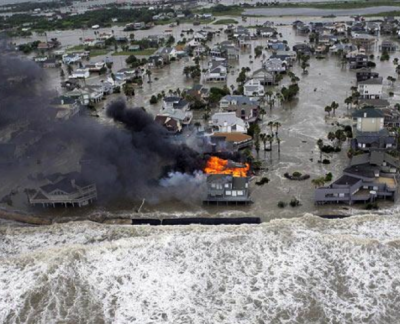Science spotlights: Difference between revisions
No edit summary |
m (→Boom-and-bust cycles of barrier island retreat: built->build) |
||
| Line 5: | Line 5: | ||
[[image:Galveston_Ike.png|400px|right|wrap|thumb|link=|Galveston Barrier Island, on September 9, 2008. Ike made its final landfall near [http://en.wikipedia.org/wiki/Galveston Galveston], [http://en.wikipedia.org/wiki/Texas Texas]. Galveston experienced a bust after a major 1900 storm, but recovered as a tourist resort from the 1930’s onwards. It remains vulnerable today.]] | [[image:Galveston_Ike.png|400px|right|wrap|thumb|link=|Galveston Barrier Island, on September 9, 2008. Ike made its final landfall near [http://en.wikipedia.org/wiki/Galveston Galveston], [http://en.wikipedia.org/wiki/Texas Texas]. Galveston experienced a bust after a major 1900 storm, but recovered as a tourist resort from the 1930’s onwards. It remains vulnerable today.]] | ||
Barrier Islands, the low-lying sandy strips separated from the coast by a lagoon, are a favorite location to | Barrier Islands, the low-lying sandy strips separated from the coast by a lagoon, are a favorite location to build beach resorts. Whereas a natural barrier system would steadily migrate with sea-level rise, barriers evolution is now dynamically coupled to human action to prevent storm erosion. CSDMS scientist '''Dylan McNamara''', currently at the University of North Carolina, has been on the forefront of coupled modeling of barrier island physical processes and human factors such as hazard mitigation driven by market development. | ||
McNamara’s model shows that barrier island are maintained at unnaturally low elevations and that this situation filters out the frequent small responses to storm events, but that the inherently instability creates longterm boom-and–bust cycles of barrier island retreat. | McNamara’s model shows that barrier island are maintained at unnaturally low elevations and that this situation filters out the frequent small responses to storm events, but that the inherently instability creates longterm boom-and–bust cycles of barrier island retreat. | ||
Revision as of 11:18, 21 December 2010
Science spotlights
Boom-and-bust cycles of barrier island retreat
Science in the spotlight: December 2010 - January 2011
Barrier Islands, the low-lying sandy strips separated from the coast by a lagoon, are a favorite location to build beach resorts. Whereas a natural barrier system would steadily migrate with sea-level rise, barriers evolution is now dynamically coupled to human action to prevent storm erosion. CSDMS scientist Dylan McNamara, currently at the University of North Carolina, has been on the forefront of coupled modeling of barrier island physical processes and human factors such as hazard mitigation driven by market development.
McNamara’s model shows that barrier island are maintained at unnaturally low elevations and that this situation filters out the frequent small responses to storm events, but that the inherently instability creates longterm boom-and–bust cycles of barrier island retreat.
References
- McNamara, D. and Werner, B., 2008. Coupled Barrier Island-Resort Model: 1. Emergent instabilities induced by strong human-landscape interactions. Journal of Geophysical Research – Earth Surface, 113, F01016, doi:10.1029/2007JF000840.
- McNamara, D. and Werner, B., 2008. Coupled Barrier Island-Resort Model: 2. Tests and predictions along Ocean City and Assateague Island National Seashore, Maryland. Journal of Geophysical Research – Earth Surface, 113, F01017, doi:10.1029/2007JF000841.

